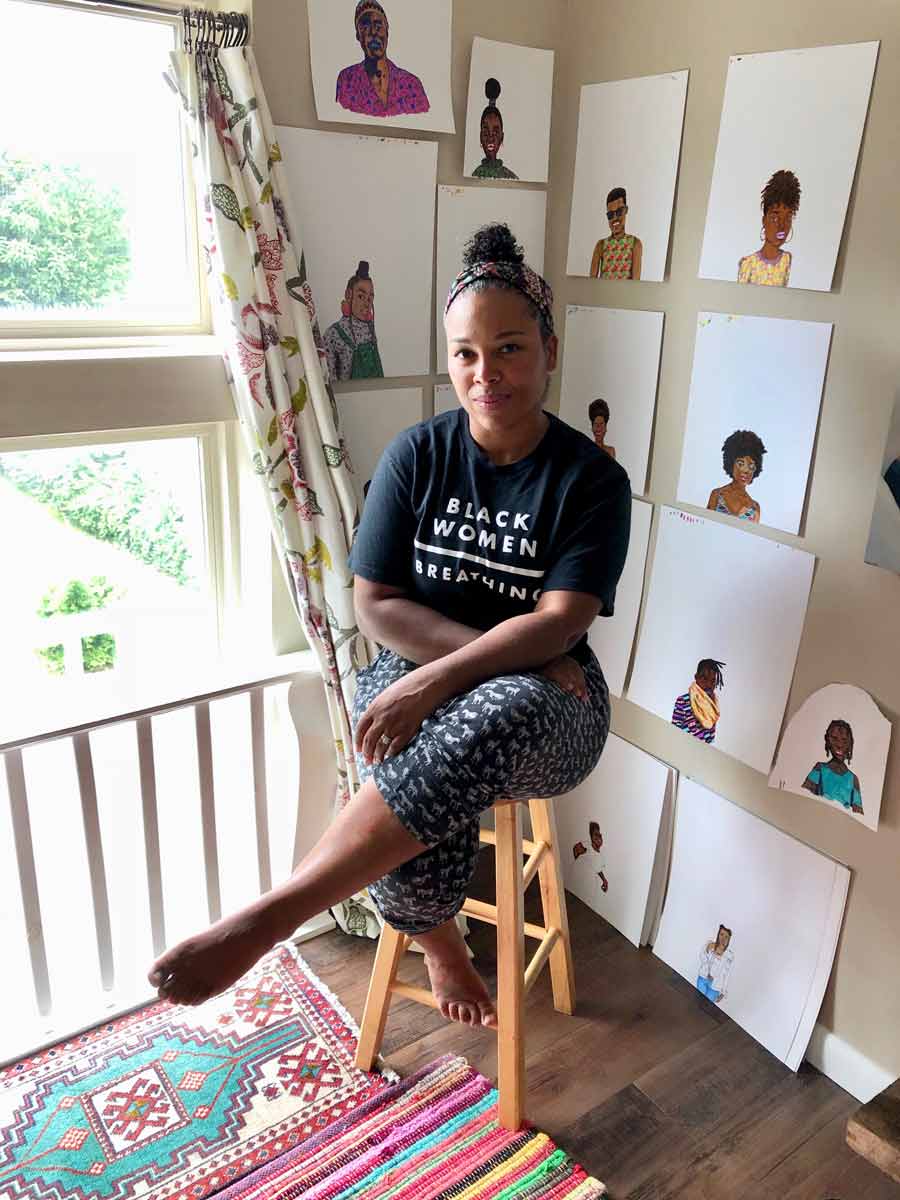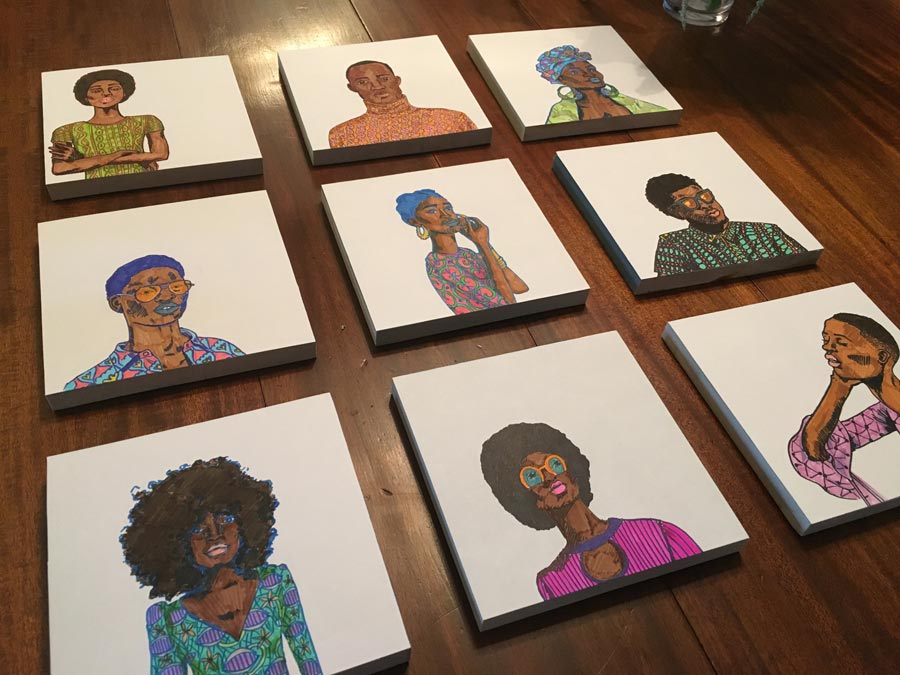Juliet Crossley is a Nashville-based portrait artist driven by an “intense desire to change the imagery of black people.” Through the application of marker on paper, Juliet uses her voice and creative gifts to promote justice, equality and the elimination of racial prejudice. Her work is inspired by the principles and teachings of the Baha’i Faith, in particular, the following letter from Abdu’l-Baha to an African American Baha’i named Robert Turner in the early 20th Century:
O thou who art pure in heart, sanctified in spirit, peerless in character, beauteous in face! Thy photograph hath been received revealing thy physical frame in the utmost grace and the best appearance. Thou art dark in countenance and bright in character. Thou art like unto the pupil of the eye which is dark in color, yet it is the fount of light and the revealer of the contingent world. – Selections from the Writings of Abdu’l-Baha, p. 114.
Juliet’s portraits feature the outer beauty of her subjects through the integration of diverse tones along with bold colors and patterns representative of the African diaspora. Juliet takes it one step further by captioning each portrait with a divine virtue, such as “Hopeful,” “Reliable,” or “Loving.” By using these spiritual virtues as titles for her work, Juliet illuminates the spiritual qualities of her subjects, endowed with divine virtue and fulfilling their noble destiny. Her work further brings to life the following words of Abdu’l-Baha, from a talk he gave at Howard University in 1912:
There are no whites and blacks before God. All colors are one, and that is the color of servitude to God. Scent and color are not important. The heart is important. If the heart is pure, white or black or any color makes no difference. God does not look at colors; He looks at the hearts. He whose heart is pure is better. – Abdu’l-Baha, The Promulgation of Universal Peace, p. 44.

Juliet Crossley in her studio.
Juliet was born in Los Angeles, to creative parents. Her mother was an actress, model and designer, her father a musician and one of the founding members of the prominent 1970’s musical duo Seals & Crofts. At the age of 2, her parents decided to relocate her family to Costa Rica, where they settled as Baha’i pioneers—not missionaries, but people who carry the Baha’i message of peace and racial harmony around the world.
For Juliet, growing up in Costa Rica became idyllic. The youngest of three children, Juliet’s parents nurtured a love of creativity in all their children early on. Juliet in particular spent many hours inventing, drawing and creating. Surrounded by her mother’s ever-evolving affinity for art and décor, Juliet also had access to her father’s music studio, where she would pluck away at instruments, writing her own original tunes surrounded by her family’s coffee plantation.
At the age of 19, Juliet returned to the United States, this time settling in Chicago to study Visual Communications & Design at The School of the Art Institute of Chicago. This was the beginning of an extremely formative period for Juliet, but it didn’t come without its challenges. Being a person of mixed race, her father Caucasian and her mother African American, the subtleties of racism and oppression challenged Juliet for the first time in her life. Having been raised as a Baha’i in a diverse and unified community in Costa Rica, Juliet felt a deficit in her new home in the United States, and did not know how to cope with the racist experiences she encountered in her own skin. She began to explore ways to communicate a greater message, integrating the constructive resilience of the African American people with Baha’i themes of justice and oneness into her creative output.
Challenged to find meaning and truth in her work, Juliet became increasingly aware of developing a mindful approach and identifying the intentions behind her artistic choices. Abdu’l-Baha described this power of intention in finding truth:
For the intention, the power and the action, all the three essential elements are brought together and the realization of everything in the contingent world dependeth upon these three principles. – Abdu’l-Baha, Tablets of Abdu’l-Baha, Volume 3, p. 691.
 Fast-forwarding to a few years later, Juliet felt the urgent need to respond to the several shootings of innocent African American men and women in the U.S. Looking to her two young girls for inspiration, she decided to inform her intentions by arming them with the truth. Juliet began to create art based on her feelings and the need to promote a positive image of black people, so that her girls could see the value in them—and in themselves.
Fast-forwarding to a few years later, Juliet felt the urgent need to respond to the several shootings of innocent African American men and women in the U.S. Looking to her two young girls for inspiration, she decided to inform her intentions by arming them with the truth. Juliet began to create art based on her feelings and the need to promote a positive image of black people, so that her girls could see the value in them—and in themselves.
Juliet launched into creating elevated ink portraits featuring real people of color, both people that she knows and others who have inspired her. Juliet’s portraits proliferated as her desire to highlight the nobility of black people grew stronger. Rooted in Baha’u’llah’s teachings that we are all created as noble and spiritual beings, she began to associate each portrait and subject with a divine inner virtue. The positive feedback to her work began to flow. Strangers shared her work, reflecting on how much their thoughts and feelings resonated with her portraits, and they increasingly recognized the divine teachings behind them:
O Son of Spirit! Noble have I created thee, yet thou hast abased thyself. Rise then unto that for which thou wast created. – Baha’u’llah, The Hidden Words, p. 9.
In her interview with Cloud9, Juliet opens up about her creative journey, and how she strives to elevate people of color in her art. We discuss how her creative work has been informed by race, faith, motherhood, identity, and profound sense of justice, all while exploring what it means to live her truth.
To show your support and follow Juliet’s work visit her Instagram account @_juliet_crossley_art

Comments
Sign in or create an account
Continue with Googleor